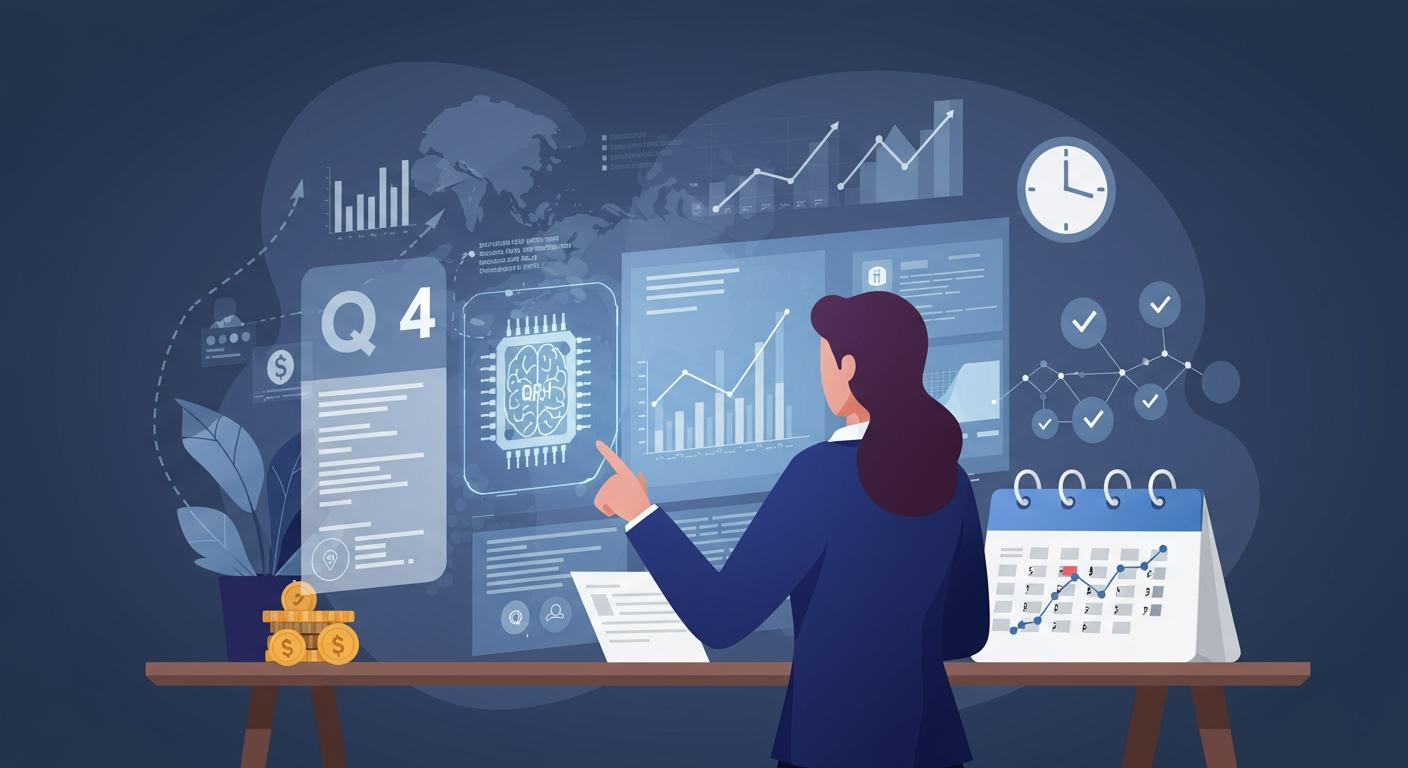How AI Predicts Delays and Saves Your Q4 Season

You know how stressful Q4 can get. Packages pile up, weather turns unpredictable, and even a small delay can cause chaos. AI Predicts Delays by tracking real-time weather, traffic, and port activity, giving you a heads-up before problems hit. You get fewer stock-outs, lower logistics costs, and better delivery times.
AI tracks demand shifts as they happen, so you can act fast.
Predictive forecasting cuts down on last-minute orders.
Smarter lead time management means shelves stay stocked.
Don’t wait—Q4 moves fast, and so should you.
Key Takeaways
AI can guess delays by looking at live data. This lets you fix issues before they happen.
Using AI to guess demand stops last-minute orders. It also helps keep shelves full when it is busy.
AI gives live updates that help make deliveries more exact. This makes sure customers get their orders on time.
AI can cut logistics costs by making stock levels better. It helps stop having too much or too little stock.
Using AI can save a lot of money. Many companies say they cut logistics costs by 15%.
Clean and sort your data often. This helps AI work well and give good guesses.
Teach your team how to use AI tools. This helps them get better and makes your work run smoother.
Be ready to change and adjust. AI can help you act fast when things change in Q4.
Q4 Challenges

Demand Spikes
You know how Q4 brings a rush like no other. Shoppers flood your website during Black Friday, Cyber Monday, and those last-minute December days. You see sales soar during events like Prime Day and Turkey 5. These moments can boost your numbers, but they also test your supply chain.
Black Friday and Cyber Monday push your team to the limit. You need to move fast, but you also want to protect your margins.
Flash sales and heavy promotions can lead to discount saturation. If you drop prices too much, you risk hurting your brand and losing out on full-price sales.
Procrastination shopping in December often leaves shelves empty. Out-of-stock issues mean lost revenue and unhappy customers.
In 2024, retailers tried to start the shopping season earlier. This helped spread out the demand and ease congestion.
Holiday spending is set to rise by about 4% over last year. Shoppers want value, but they also want a good experience.
You need to keep your inventory and supply chain in sync. If you can’t fulfil those big promotional offers, you lose trust and sales.
Supply Chain Risks
Q4 doesn’t just bring more orders. It brings more risks, too. You face challenges from every direction. Take a look at some of the most common risks:
Risk Type | Description |
|---|---|
Economic Instability | Ongoing geopolitical instability affecting logistics and increasing operational costs. |
Regulatory Compliance Pressures | Compliance burdens from emissions regulations and trade policy shifts creating financial shocks. |
Environmental Concerns | Impending climate compliance deadlines forcing carriers to integrate carbon costs into operations. |
You might see costs rise and demand shift because of global events. New rules about emissions and trade can hit your bottom line. Carriers now have to factor in carbon costs, which can make shipping more expensive.
Lockdowns and wars can drive up the price of raw materials.
Higher costs make it harder to get the goods you need.
Cost of living increases can affect your most vulnerable customers.
You need to stay flexible and ready to adapt. If you don’t, you risk falling behind.
Cost of Delays
Delays in Q4 can cost you more than just money. You might see your costs jump overnight. For example, in Q4 2024, the cost of goods sold in cosmetics and pharmaceuticals shot up by 103% compared to Q3. The wood and timber industry saw an 84% increase, but managed to keep up by raising prices. Fashion brands faced rising costs, which cut into their profits.
If you can’t deliver on time, you lose sales and damage your reputation.
Over-discounting to clear stock can eat away at your margins.
You need to react quickly to promotions. If you don’t, you risk overstocking or running out.
Tip: Stay alert and use real-time data to spot problems early. Quick action can save your Q4 season.
AI Predicts Delays
When Q4 gets busy, you need more than guesses to keep deliveries moving. AI Predicts Delays by using lots of real-time data and turning it into simple advice. Here’s how it helps you.
Data Analysis
You get loads of information every day. AI Predicts Delays looks at huge sets of data that people can’t handle alone. It checks things like:
Weather reports and warnings about storms.
Traffic updates and past traffic problems.
Port activity, like how busy it is and how long unloading takes.
Sensor data from your supply chain and IoT devices.
Different types of data, such as text, numbers, and pictures.
AI Predicts Delays does more than collect data. It links facts together. If a storm is near a port, AI Predicts Delays warns you early. You can change delivery routes or times before trouble starts.
Description | |
|---|---|
High-frequency SC data | Sensor data, IoT |
Multimodal data integration | Text, time series, images |
Long-term risk forecasting | Essential for effective risk prediction |
Tip: Use AI Predicts Delays to spot problems early. You save time and avoid big mistakes.
Pattern Recognition
You may wonder how AI Predicts Delays finds problems so fast. It uses pattern recognition. AI Predicts Delays scans your logistics data for signs people might miss. It finds trends, like more traffic jams near your centres or slowdowns at ports.
AI Predicts Delays watches live data, like weather and traffic.
It spots patterns that often mean delays, like sudden traffic spikes.
It learns from old problems, so it gets better every year.
Here’s how things are changing in the industry:
Statistic/Fact | Description |
|---|---|
The global AI in logistics market could reach $26.3 billion by 2025. | |
AI Adoption | Over 65% of logistics companies now use AI-powered solutions. |
Perception of AI | 93% of fleet operators say AI boosts resilience and adaptability. |
🚦 Note: AI Predicts Delays can send alerts if a parcel stops or a route has trouble. You can fix things before customers notice.
Predictive Models
You want to stop problems before they happen. Predictive models help with this. AI Predicts Delays uses smart forecasting tools with real-time and old data. These models show what might happen next, not just what’s happening now.
Forecasting with data helps you see demand and spot slowdowns.
Automation links your systems, so information moves easily.
Predictive analytics show demand spikes sooner than old ways.
If AI Predicts Delays sees delays from heavy rain in one area, it can suggest new routes or delivery times. You stay ready, even when Q4 is busy.
Callout: Updates from AI Predicts Delays let you warn customers about possible delays or offer other delivery choices. This builds trust and keeps your brand strong.
AI Predicts Delays gives you tools to act quickly, save money, and keep your promises—even when Q4 is tough.
AI Solutions

Demand Forecasting
You want to know what customers will buy early. AI helps with this. It checks lots of data from sales and website visits. It also looks at social media trends. You get updates as soon as demand changes. AI does not guess. It learns from past years and finds new patterns quickly.
Here is how AI demand forecasting is different from old ways:
Aspect | AI Demand Forecasting | Traditional Methods |
|---|---|---|
Data Integration | Real-time data integration from diverse sources | Limited data integration |
Modelling | Uses advanced algorithms like deep learning | Relies on simpler statistical methods |
Adaptability | Adapts to market changes in real-time | Static predictions based on historical data |
Scenario Planning | Provides predictive insights for multiple scenarios | Limited scenario analysis |
Decision Support | Offers actionable recommendations | Primarily focuses on trend prediction |
Accuracy | Higher accuracy due to large dataset analysis | Lower accuracy with higher error rates |
Cost Efficiency | Reduces overstocking and stockouts | Often leads to excess inventory |
Customer Satisfaction | Improves product availability and reduces stockouts | May result in stockouts or overstocking |
You get more than numbers. AI gives advice you can use now. It helps you avoid buying too much. It keeps shelves full when demand goes up. You do not need to worry about missing sales because you ran out of stock.
Tip: AI demand forecasting helps you react fast to trends. You will not get surprised during Q4.
Inventory Optimisation
It is hard to keep the right amount of stock in Q4. Too much stock wastes money. Too little makes customers unhappy. AI helps you find the best balance. It checks sales, supplier lead times, and weather forecasts. This makes sure you have what you need, when you need it.
A retailer used an AI inventory system. They saw a 20% drop in stockouts. They also had a 12% cut in overstocking during busy holiday weeks. You save money and keep customers happy. Using AI lowers your inventory holding costs by 25%. It also boosts sales by 15%. That is great for your business.
AI tracks your inventory in real time.
It predicts when you will run low and tells you when to reorder.
You avoid panic buying and last-minute discounts.
🎯 Note: AI Predicts Delays helps you spot supply chain slowdowns early. You can change your stock levels before problems start.
Delivery Accuracy
Getting orders to customers on time matters most in Q4. AI makes deliveries smarter and faster. It checks live traffic, weather, and old delivery data. This helps pick the best routes. You get fewer missed deliveries and happier customers.
AI uses predictive analytics to forecast delivery windows well.
Machine learning models learn from each delivery. Your time estimates get better.
Real-time data lets you change driver routes quickly. Parcels arrive when promised.
You do not have to guess if a delivery will be late. AI gives updates and helps fix problems before customers notice. Your brand reputation stays strong. You build trust with every order.
🚚 Callout: With AI, you can promise delivery dates with confidence, even when Q4 is busy.
Results

Case Studies
You might wonder how AI changes things for big companies during Q4. Let’s look at some real examples.
Walmart started using AI to make its supply chain smarter. You see the results in their numbers. They saved about $75 million in one year. They also cut down nearly 72 million pounds of CO₂ emissions. That’s good for business and the planet.
Many logistics companies use AI for demand forecasting and risk checks. You get fewer mistakes. Some firms saw errors drop by 50%. They also spent 15% less on logistics. That means more money stays in your pocket.
Retailers who switched to AI-based inventory systems found their shelves stayed full. Customers got what they wanted, even during busy holiday weeks. You avoid empty shelves and unhappy shoppers.
🎉 When you use AI, you see fewer errors, lower costs, and happier customers. Your Q4 season runs smoother.
Key Stats
You want proof that AI makes a difference. Here are some numbers that show how much you can gain:
Improvement Type | Measurable Improvement |
|---|---|
Warehouse slotting optimisation | |
AI-based labour allocation | 20% reduction in idle time |
Predictive maintenance | 12% drop in equipment downtime |
You see these improvements in real life. When you optimise warehouse slotting, you move products faster. AI-based labour allocation means your team spends less time waiting around. Predictive maintenance keeps your machines running, so you avoid costly breakdowns.
Companies using AI for logistics saw sales rise during Q4. You keep shelves stocked and customers happy.
Fewer empty shelves mean you don’t lose sales. You build trust with shoppers who know they can rely on you.
You save money on logistics and cut down on waste. That helps your bottom line and makes your business stronger.
📈 With AI, you get better results every Q4. You spend less, sell more, and keep your promises.
You don’t have to guess if AI will help your business. The numbers and stories show real gains. When you plan for Q4, you can trust AI to keep things running smoothly.
Getting Started
So, you want to bring AI into your Q4 operations. You might feel unsure where to begin, but you can break it down into simple steps. Let’s walk through what you need, how to choose the right solution, and how to set up your team for success.
Data Needs
You can’t run AI without good data. Think of data as the fuel for your AI engine. You need the right types, and you need them to be clean and organised. Here’s a quick look at the main areas you should cover:
Description | |
|---|---|
Demand Forecasting | Use past sales data to predict what customers will want next. |
Dynamic Pricing | Track real-time sales and market trends to adjust prices quickly. |
Predictive Maintenance | Watch equipment and vehicles to spot problems before they cause delays. |
Risk Management | Monitor for risks like weather or supply chain issues to act fast. |
💡 Tip: Start by checking if your data is up-to-date and easy to access. Clean data helps AI work better and faster.
Solution Choice
Choosing the right AI tool can feel tricky, but you can make it easier by following a few key steps. You want a solution that fits your business and helps you reach your goals. Here’s a table to help you compare what matters most:
Description | |
|---|---|
Audit current processes | Spot where things slow down or repeat in your supply chain. |
Evaluate data readiness | Make sure your data is accurate and well-organised. |
Set measurable goals | Decide what you want AI to improve, like faster deliveries or fewer errors. |
Build an AI strategy and roadmap | Plan which projects to start first and when to roll them out. |
Invest in the right tools | Pick between ready-made or custom AI solutions for your needs. |
Train your workforce | Teach your team how to use AI and work with new systems. |
Monitor and adjust | Keep checking how AI performs and tweak your approach as you go. |
🛠️ Note: Don’t rush. Take time to match your AI solution to your biggest Q4 challenges.
Team Setup
You need the right people to make AI work for you. Here’s a simple plan to get your team ready before Q4 hits:
Find tasks that take up lots of time but don’t carry much risk. These are great places to start with AI.
Make sure your first AI projects solve problems that matter to your leaders.
Link your AI work to activities that connect across your business, not just single tasks.
👥 Callout: Bring together people from IT, operations, and sales. When everyone works together, you get better results.
Checklist for AI Integration Before Q4:
Review and clean your data.
Choose an AI solution that fits your needs.
Set clear goals for what you want to achieve.
Train your team on new tools.
Start with small, high-impact projects.
Keep checking progress and adjust as needed.
You don’t need to do everything at once. Take it step by step, and you’ll be ready for a smoother, smarter Q4 season.
Challenges

Data Quality
You want your AI to do a good job. It needs good data to work well. If your data is messy, the AI will make mistakes. Old or missing data can cause wrong predictions. You might not see important trends. Check your data often to keep it clean and up to date.
Ask yourself some questions:
Are any sales numbers missing?
Did you record delivery times the right way?
Is your product information clear and correct?
If you find problems, fix them quickly. Good data helps your AI learn faster. It also helps it make better choices. You will get fewer mistakes and more useful ideas.
💡 Tip: Check your data often. Clean data means your AI works better and Q4 has fewer surprises.
Change Management
Using AI in Q4 means things will change. Some people might worry about new tools. Others may not know what to do next. You can help by making a good plan. A strong change management plan helps everyone feel ready.
Here are some ways to help your team:
Strategy | Description |
|---|---|
Multi-tiered implementation team | Involves cross-functional members to ensure diverse insights are included in the process. |
Align change plans with sales targets | Ensures that the change plan supports existing sales goals, making it relevant to revenue generation. |
Effective training methods | Focuses on equipping the team with necessary skills to confidently use new tools. |
Ongoing support | Establishes a structured support system to maintain momentum post-launch. |
Clear communication strategies | Involves thoughtful messaging that reaches all team members, tailored to different roles. |
Build a team from different departments. This brings new ideas and helps everyone feel part of the change. Link your plan to sales goals so the team sees why it matters. Give your team time to learn and practise with AI tools. Keep helping after you start using AI. If someone has a question, they should know who to ask. Clear messages help everyone stay on track.
🚀 Note: Change is easier when you talk openly and help your team all the way.
Success Metrics
You want to see if your AI is working well. You need clear ways to measure success. These metrics show what is good and what needs work. You can track how much your team uses AI. You can see if tasks get done faster. You can check if business results improve.
Here are some common ways to measure success:
Metric Type | Examples of Metrics |
|---|---|
Usage Metrics | Daily/weekly active users, Feature adoption rates, Time spent using AI tools, Completion rates for AI-suggested actions |
Productivity Metrics | Task completion time reduction, Output quality improvements, Error rate changes, Process automation success rates |
Business Impact Metrics | Revenue per employee improvements, Customer satisfaction scores, Time-to-market reductions, Cost savings from automation |
You might see more people using AI each week. Tasks may take less time. Customers could give better feedback. You might save money or sell more. These numbers help you show the value of AI in Q4.
📊 Tip: Watch your metrics. They help you see what works and find ways to get even better.
Future-Proofing

Continuous Improvement
You want your AI systems to keep getting better. They should not just work well one time. Continuous improvement helps you stay ahead in Q4. You can check how your AI is doing by looking at key numbers. These include booking accuracy and on-time delivery. Regular checks show what is working and what needs fixing. Training your team is important too. When your staff know how to use AI tools, you get more value. They can also read the data better. New technology comes out often. You can make your logistics better by adding new tools. Make sure everything works together.
Strategy | Description |
|---|---|
Performance Monitoring | Regular checks of KPIs like booking accuracy and on-time delivery help you spot issues early. |
Employee Training | Training your team means they can use AI tools and understand the data better. |
Integration of Technologies | Adding new tech keeps your logistics sharp and ready for change. |
💡 Tip: Keep checking your AI setup. Small changes can help a lot during busy times.
Scaling AI
Q4 brings more orders and more data. Your AI needs to handle the rush. Cloud platforms help you grow fast. You can add more power when you need it. This way, your systems do not slow down. Strong data pipelines keep information moving, even when things get busy. MLOps helps you automate tasks. This means your AI keeps learning and getting better as your business grows.
Use cloud platforms and strong hardware to boost your AI when demand goes up.
Build strong data pipelines and storage so your AI always has the information it needs.
Use MLOps to automate training and keep your AI working well as you grow.
🚀 Note: If you plan for growth, your AI can handle anything Q4 brings.
Market Trends
AI in supply chain management keeps changing. You see new trends shaping how businesses work. Generative AI now helps you plan for many situations. Autonomous logistics means less manual work in warehouses and on the road. When you mix AI with blockchain and IoT, you get better data and more transparency. Edge AI lets you make decisions right where things happen. This cuts down on delays. More companies are joining together through mergers and acquisitions. This shows how important new ideas are right now.
Trend Description | Impact on Supply Chain Management |
|---|---|
Integration of generative AI | Helps you forecast and plan by simulating complex situations. |
Rise of autonomous logistics | Cuts down on manual work and boosts efficiency. |
Fusion of AI with blockchain and IoT | Gives you real-time data and better decision-making. |
Deployment of edge AI | Lets you make quick decisions on the spot, reducing delays. |
Increase in mergers and acquisitions | Shows the race for new ideas and staying ahead in the market. |
📈 Callout: Watch these trends. They help you get ready for the future and keep your Q4 strong.
You can see how AI helps you find problems early. This keeps your Q4 season running well. Real-time insights help you plan ahead. You stay in front of delays and issues. Here is what you get:
You make faster and better choices with digital supply chain tools.
Automation lowers costs and gives better customer service.
You can change routes quickly and lose less money if there are problems.
Efficiency goes up—some companies get 30% better in the first year.
Benefit | Description |
|---|---|
Enhanced Efficiency | Logistics become quicker and smoother each day |
Cost Reduction | Automation and optimisation help you save money |
Better Customer Service | Reliable delivery meets higher expectations |
Resilience to Disruptions | You adapt fast when things change |
Now is the best time to start. Plan your AI journey before Q4 begins. You will get better results, happier customers, and a stronger business.
FAQ
How does AI spot delivery delays before they happen?
AI checks real-time data like weather, traffic, and port activity. It finds patterns that often lead to delays. You get early warnings, so you can act fast and keep your deliveries on track.
Will AI replace my team in Q4?
No, AI helps your team work smarter. It takes care of boring tasks and gives you better information. Your team can focus on important jobs and make better decisions.
Is it hard to start using AI for my supply chain?
You can start small. Clean your data and pick one area to improve, like demand forecasting. Many AI tools are easy to set up and use. You do not need to change everything at once.
What if my data is not perfect?
AI works best with good data, but you do not need perfect records to begin. Start by fixing the biggest gaps. Over time, your data will get better, and AI will give you more accurate results.
Can AI help with last-minute Q4 changes?
Yes! AI reacts quickly to new problems. If a storm hits or demand spikes, you get instant updates. You can change routes or stock levels before issues grow.
How much money can I save with AI in Q4?
Many companies see savings of 15% or more on logistics costs. You also avoid lost sales from empty shelves. AI helps you spend less and sell more during the busiest season.
Do I need a big IT team to use AI?
Not always. Many AI solutions work in the cloud and need little setup. You can use outside partners or start with simple tools. Your current team can learn to use AI with some training.

TangBuy: A Smarter Way to Dropship in 2025
If you're looking to stay competitive with dropshipping in 2025, speed and trend-awareness are key. TangBuy helps you stay ahead with real-time product trends, fast fulfilment, and factory-direct sourcing. With over 1 million ready-to-ship items, 24-hour order processing, and seamless Shopify integration, TangBuy makes it easier to test, scale, and succeed in today's fast-moving eCommerce landscape.
See Also
Common Supplier Communication Errors And Their Solutions
Strategies For Managing High Wholesale Prices In 2025
Essential TikTok Advertising Spy Tools For 2025 Marketers
Comprehensive Guide To CJdropshipping Chrome Extension In 2025
Newcomer's Handbook For Increasing eBay Arbitrage Profit Margins

